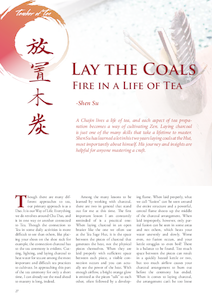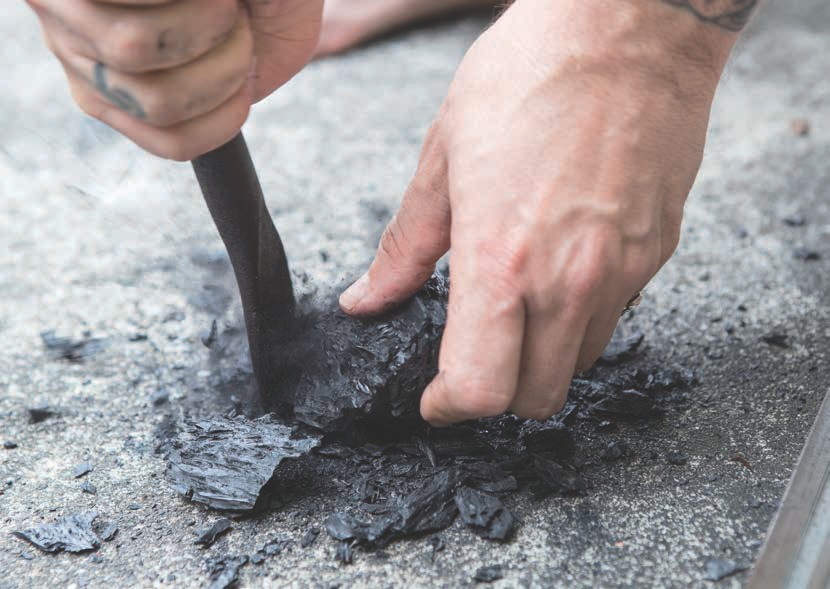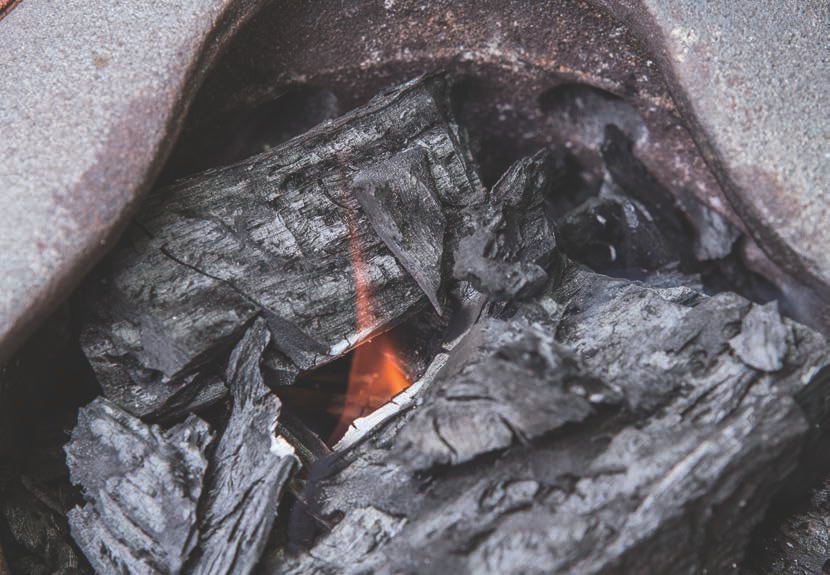
 |
|

Though there are many different approaches to tea, our primary approach is as a Dao. It is our Way of Life. Everything we do revolves around Cha Dao, and is in one way or another connected to Tea. Though the connection to Tea in some daily activities is more difficult to see than others, like placing your shoes on the shoe rack for example, the connection charcoal has to the tea ceremony is evident. Cutting, lighting, and laying charcoal to heat water for tea are among the most important and difficult tea practices to cultivate. In approaching this part of the tea ceremony for only a short time, I can already see the road ahead to mastery is long, indeed.
Among the many lessons to be learned by working with charcoal, there are two in general that stand out for me at this time. The first important lesson I am constantly reminded of is a practical one: When laying charcoal in an open brazier like the one we often use at the Tea Sage Hut, it is the space between the pieces of charcoal that generates the heat, not the physical pieces themselves. When they are laid properly with sufficient space between each piece, a visible connection occurs and you can actually see the power of the heat. With enough airflow, a bright orange glow is emitted as the pieces "talk" to each other, often followed by a developing flame. When laid properly, what we call "fusion" can be seen around the entire structure and a powerful, central flame shoots up the middle of the charcoal arrangement. When laid improperly, however, only partial fusion can be seen in some areas and not others, which heats your water unevenly and slowly. Worse even, no fusion occurs, and your kettle struggles to even boil! There is a balance to be found. Too much space between the pieces can result in a quickly heated kettle or two, but too much airflow causes your charcoal arrangement to burn out before the ceremony has ended. When it comes to laying charcoal, the arrangement can't be too loose nor too tight. Too loose, and your arrangement burns out early. Too tight, and it struggles to burn at all. It takes time to find that balance, and the balance shifts based on how many people there are and what type of tea ceremony you have chosen: gongfu tea, bowl tea, or whisked tea. Of course, there are countless other factors to consider as well. There are many different braziers, charcoal types, and methods of cutting, starting, and laying the charcoal. It is a challenge, to say the least, to properly lay charcoal for tea, let alone create an art out of it, but a worthwhile challenge for the Chajin!

For most tea ceremonies, we use a locally produced charcoal made of compressed coconut husks. The briquettes are compressed into hexagonal logs with a hole down the middle to increase surface area and to promote airflow. The hexagonal shape makes laying the charcoal easier. With the right tools and attention, the briquettes can be cut easily into thin slivers or medium to large pieces. The number of different pieces depends on the brazier and the occasion. For gongfu tea, I use a smaller kettle and slightly less charcoal than for bowl tea. If the arrangement is too big in relation to the size of the kettle, it tends to heat the handle, making it uncomfortable to hold. For bowl tea, I use more charcoal, arranged with a larger opening or "door" to allow more airflow to heat larger kettles.
To achieve proper spacing and airflow, it is most important to cut your charcoal well and in the right volume. I use a simple chisel or cleaver to cut our charcoal by hand. After cutting the pieces to the desired sizes, I adjust any sharply angled pieces to create a flatter surface, which is important for laying a stable foundation within the brazier. Then I light them on a gas stove. I lay the lit charcoal in a circular shape in the center of our brazier. Easier said than done. Speed is important to achieve "fusion," and so that your hibashi (metal chopsticks for charcoal) don't get too hot to handle. At this point, I often place a small piece of unlit white charcoal in the center of the arrangement. White charcoal is very dense charcoal that burns longer and hotter than others. Using it at the center of a charcoal arrangement is a good way to keep your fire burning longer and hotter. Having properly cut surfaces on each charcoal piece allows you to lay a stable structure that either stands up straight or slightly angles towards the center. At the end of a tea session, a good charcoal arrangement will collapse inward. Again, with properly cut, lit, and laid charcoal and a skilled consideration of the space between the pieces, "fusion" is much more likely to happen. But it's not some phenomenon that just happens when all the practical factors line up. There is more to it than that, which brings me to my second, more inward lesson.
Everything we do is part of the tea ceremony. All of our daily activities are a clearing away of the last session and a preparing for the next one, quite literally. As a Chajin, how you clean up after a tea session is how you make tea. How you do everything is part of the overarching tea session for the one who lives a life of Tea. More generally speaking, how you do anything is how you do everything. Everything at the Hut revolves around Tea. Therefore, how we do anything is how we do Tea.
Working with charcoal is not just some job to finish - some means to an end. It's not a task to get done so that we can finally sit down and drink tea; it is the process of drinking tea. My teacher says, "Zen is the art of creating sacred space around everyday activities." That means shifting one's perspective. The only thing that separates everyday activities from sacred ones is our discriminating mind. Working with charcoal can be done with sacred intention, mindfulness, and reverence, or it can be viewed as an everyday chore falling somewhere between breakfast and drinking tea. How we orient ourselves makes all the difference. That's exactly why Tea is such a good medicine for these times, because it is so ordinary: just leaves and hot water. And yet, She can be consciously raised up to be sacred and ceremonial, which is something so many of us have lost touch with. That's part of the reason so many of us are drawn to Her. Tea is the point at which spiritual progress and worldly joy intersect. That being said, the lesson here is that my orientation towards working with charcoal can completely shift it from being a task to being an honor. How to achieve that shift in orientation is different for each individual, but the results will manifest as progress and improvement. As I said before, there is more to creating a fine charcoal arrangement than simply lining up all the practical factors. Like the ingredient of love that makes a mother's soup better than any other, the remaining factor is orientation when it comes to consistently laying charcoal well. Mindfulness, attention, and reverence will improve the quality of everything we do, whether that be cooking food, setting down shoes, or laying charcoal.
I still make a lot of mistakes when working with charcoal. It's a great feedback system, demonstrating where I'm at and how many mistakes I've either learned from or failed to learn from. At present, I still have lots of work to do and many lessons to learn. Sometimes I lay charcoal well and other times terribly. If how I do anything is how I do everything, then through working with charcoal, I can see my work is patchy and needs cleaning up! At the same time, even the imperfection is Zen. It was never meant to be done perfectly, just well. And done well means with heart.

Like all aspects of tea preparation, each activity offers an opportunity to create sacred space around it. Working with charcoal is particulary important as it creates the heat, without which there would be no tea. It is the fire and light, the very life of the tea ceremony itself. Traditionally, a person's house was centered around an altar to connect to the Divine, or the hearth, acting as the warm heart of the home. So too, a well-lit charcoal arrangement within a brazier centers the ceremony around its light and warmth. With this in mind, I aspire to tend the flame of the ceremony with honor and reverence. This is the orientation with which to approach charcoal for tea ceremony. This is the frame of mind with which I surround the art of working with charcoal for tea.

放 置 木 炭 是 修 行
